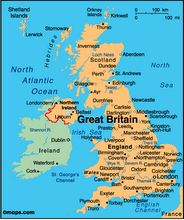Hampton Court Palace is a royal palace in the London Borough of Richmond upon Thames, just south-west of London. It has not been lived in by the British royal family since the 18th century. Hampton Court was originally built for Cardinal Wolsey, one of Henry VIII's favourites, in around 1514. In 1529, as Wolsey fell from favour, the palace was handed to the king, who enlarged it. The following century, King William III undertook a massive rebuilding and expansion project, intended to outshine the French palace at Versailles.
We began our visit with a tour of King Henry VIII's State Apartments. The Great Hall was very impressive - this is where a lot of the lower ranks of Henry's court used to eat. The room is 32m long by 12m wide and would hold up to 600 people over two sittings, for two meals a day. The beautiful hammer-beam roof (see photo below) was originally painted red, blue and gold. We also passed through the Great Watching Chamber and saw inside the Chapel Royal. King Henry amassed an immense collection of tapestries - around 600 - and some of those surviving tapestries still decorate the walls throughout Hampton Court Palace today.
The first of the three large courtyards within the palace is the Base Court. This spacious courtyard provided a cramped but luxurious home for members and guests of the court. Beyond the Anne Boleyn Gateway is Clock Court - the heart of the palace and named after the extraordinary Astronomical Clock above the gateway. The third and final courtyard is the Fountain Court, a beautiful square of grass with a majestic fountain in the centre. It was around here that Henry and his wives had their private apartments.
Next we visited the Tudor Kitchens. Even though a large part of the Tudor Kitchens is no longer accessible, we were still able to visit a massive set of kitchens. The route is laid out showing where the raw food - mainly meat - came in and was processed, through storage rooms, to massive roasting ovens where it was cooked and out the other end, where the cooked food was taken to the royal court. Apparently King Henry's diet was made up of 75% meat.
The kitchens contain replica food and utensils to show exactly what things would have looked like in the 1500s. The massive chunks of meat were usually roasted over an open fire, although sometimes they were cut up and cooked in a huge cauldron or cooked as pies in pastry cases. There is a narrow alleyway running alongside the kitchens called Fish Court. There are a number of small store rooms along this alleyway, which were used as fridges to store raw ingredients. The alleyway is narrow running north to south so that no sun shines down there. It is open to the air and the rooms are small with thick stone walls which used to keep the stores nice and cool.
Next we visited the King William III State Apartments. The entry to these apartments is by an opulent staircase, where the walls and ceiling are decorated with magnificent paintings. Through the King's Guard Chamber (with 2,850 pieces of arms and armour) is a long corridor, off which there are various bedchambers, meeting rooms, closets and eating rooms. We decided not to visit the Queen's State Apartments or the Georgian Rooms - we could still be there now if we had seen everything!
Instead we opted to visit two exhibitions: the Young Henry Story, which focused on Henry from the time he became king throughout his marriage to his first wife, Katherine of Aragon; and a portrait exhibition of Henry's six wives, amongst others.
The Palace Gardens are enormous. We walked out of the palace and down the path through the Great Fountain Garden. We sat on the lawn in the sun and had a snack before continuing our walk through the beautiful gardens, amongst the perfectly manicured trees, bright-coloured flower beds and stone statues. There is a hedge maze at one end of the gardens, which is actually larger and more difficult to solve than it looks from the outside. Still, we managed to find out way to the centre after a few wrong turns!

Hampton
Court
Palace
entrance

Ceiling in
the Great
Hall

One of
many
tapestries

Base
Court

Astro-
nomical
Clock

King Henry
VIII


Fountain
Court

Palace
Gardens







No comments:
Post a Comment